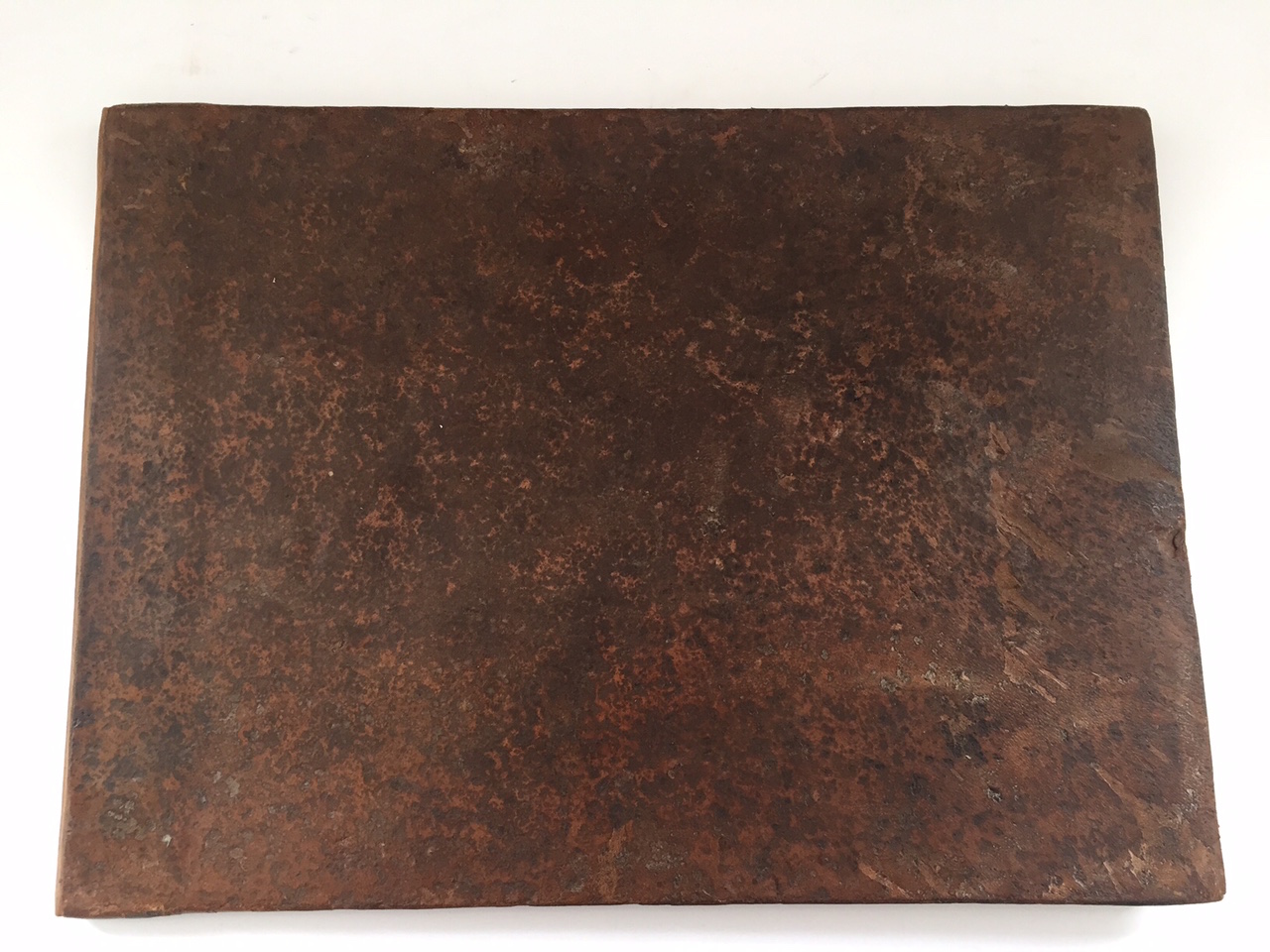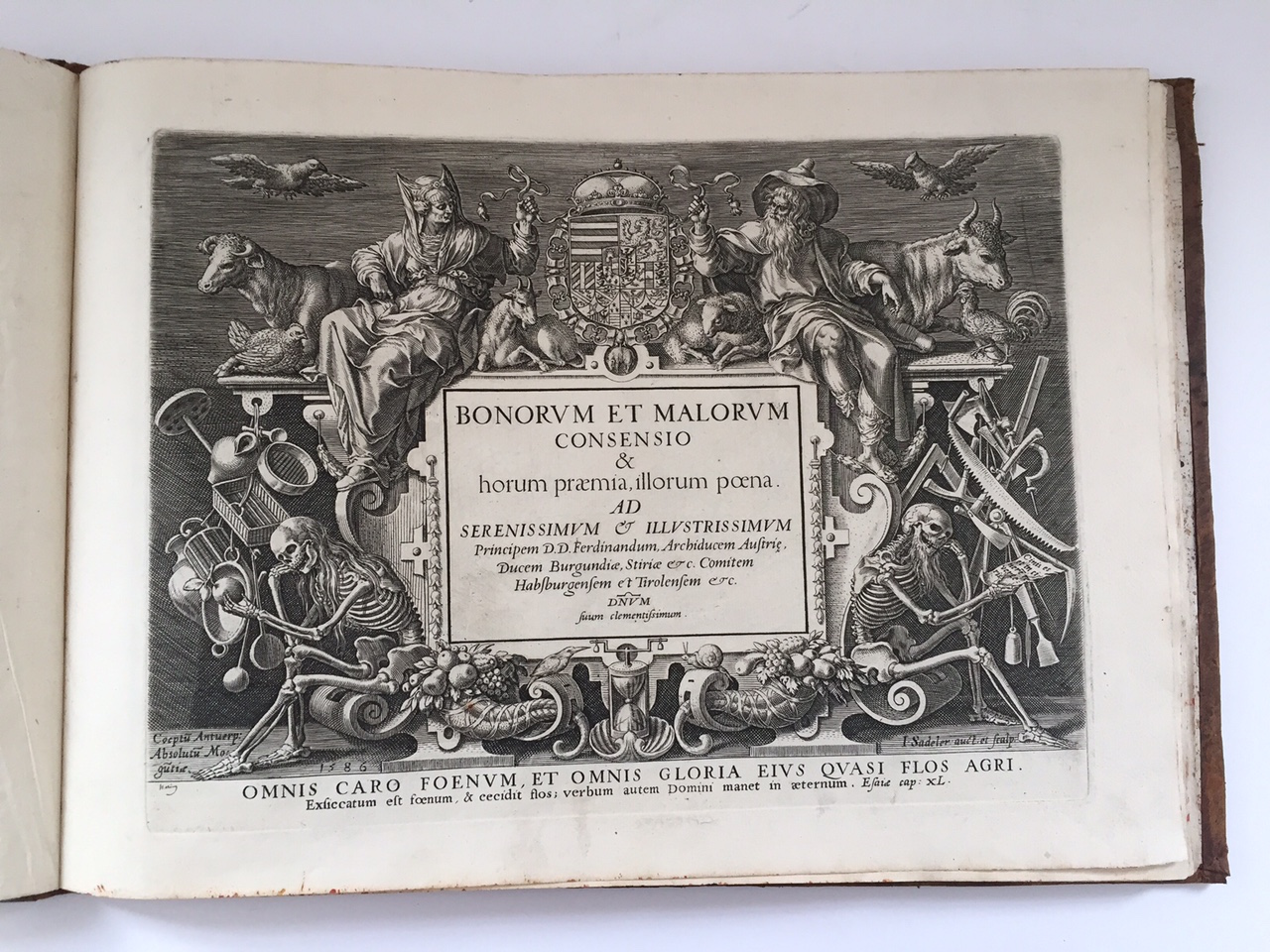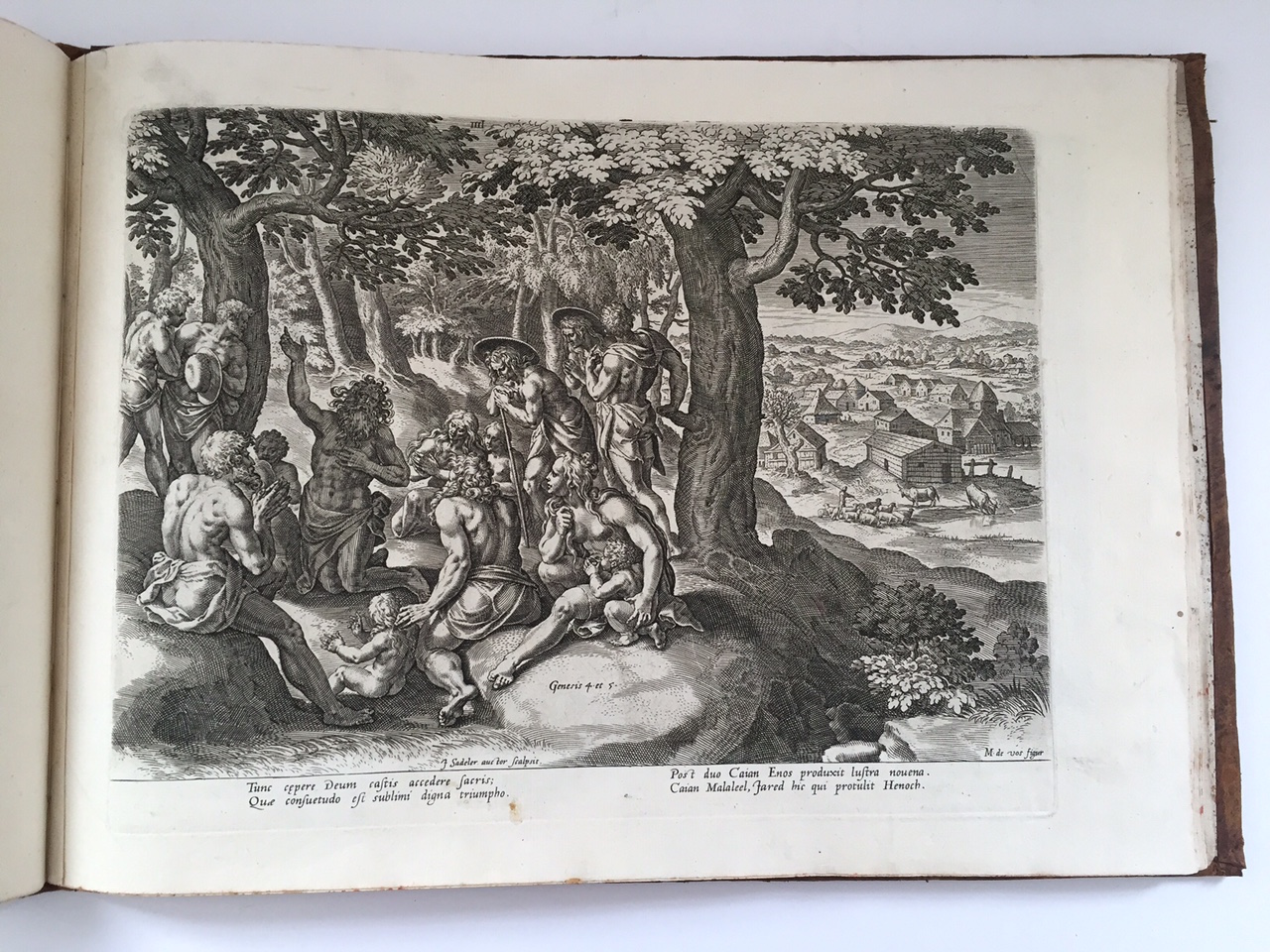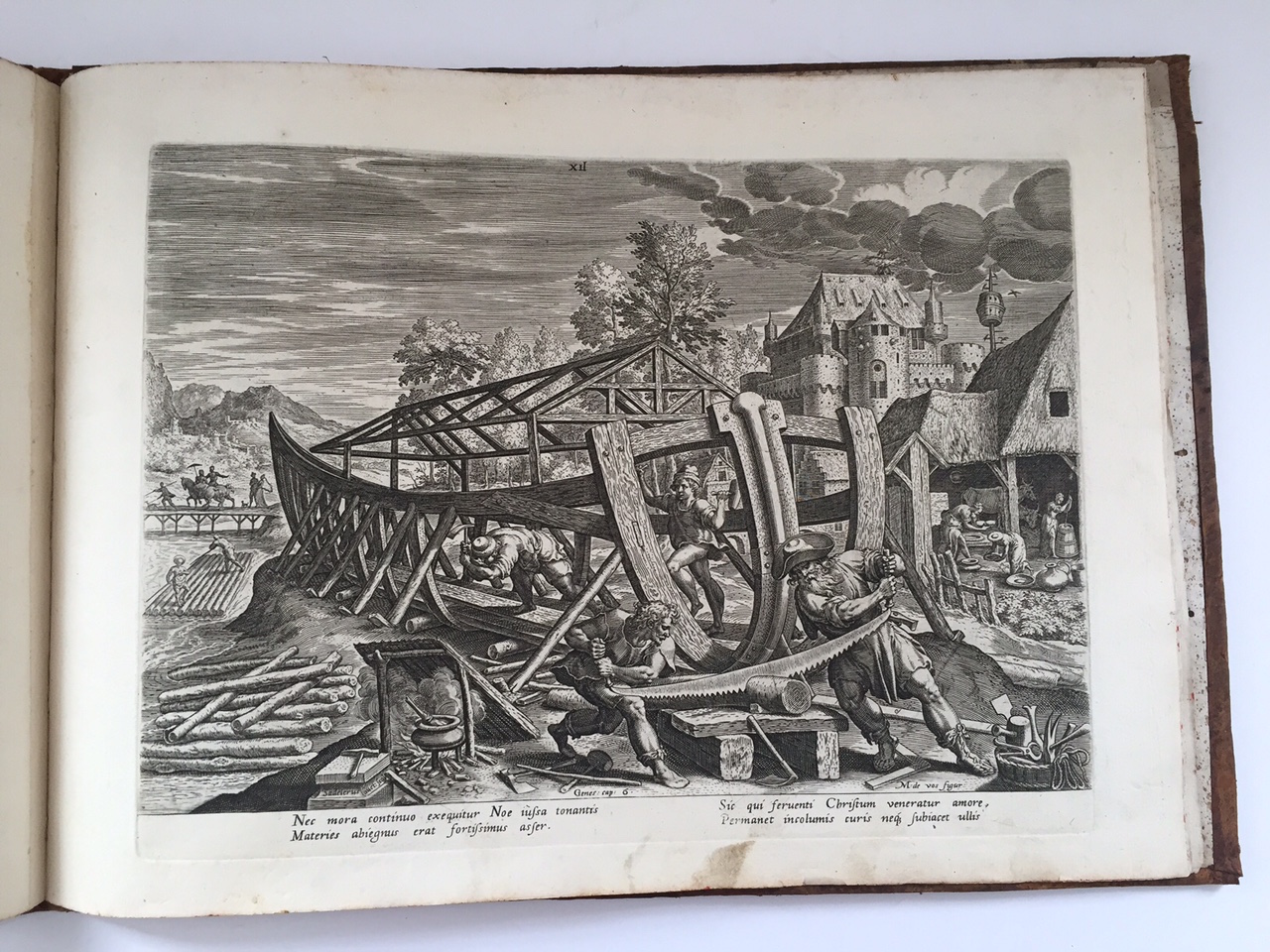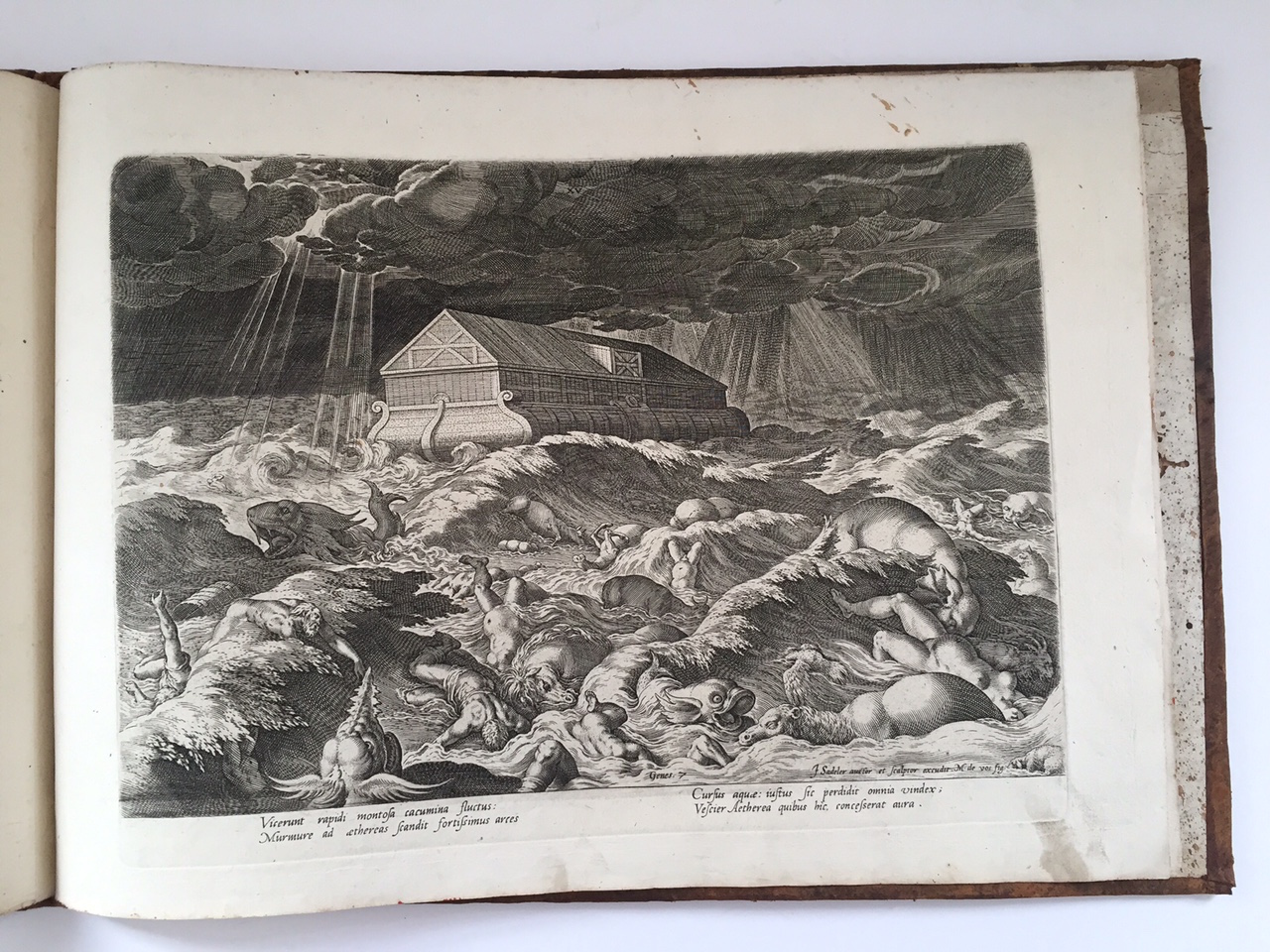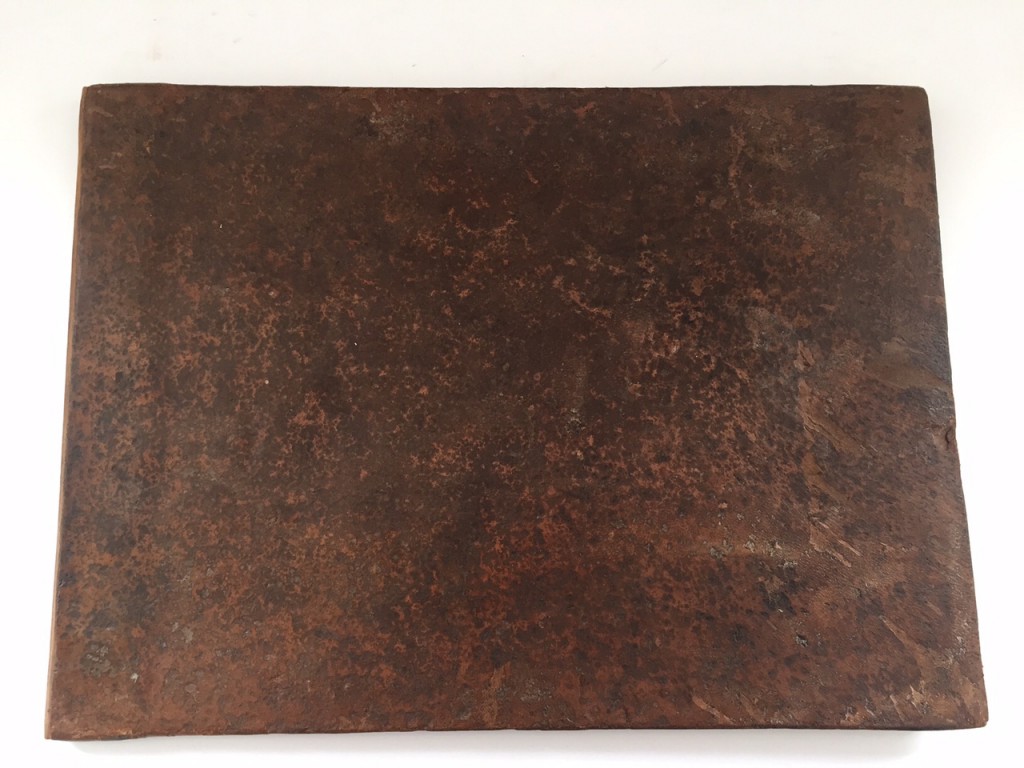SADELER, Johann
Bonorum et Malorum Consensio: The Knowledge of Good and Evil. The Story of the Family of Seth
Antwerp, np, 1586£4,950.00
15 intaglio engravings on thick laid paper, based on images from Genesis, mainly after drawings by Maarten de Vos. Slightly dusty in borders, a couple of small wormholes affecting blank margin only. Engravings measure 276×210 mm, sheets 245×335 mm. Explanation below each scene in a clear italic. A very good, uncropped copy in contemporary sheep, a little worn, rebacked.
I) TITLE PAGE
Central architectural title. On the left, the skeleton of Eve, sitting in contemplation of the fruit of the tree of knowledge against a backdrop of farming implements, on the right, the skeleton of Adam, holding scroll proclaiming ‘You are dust and unto dust you shall return’ against a background of carpentry tools. At the foot, two horns of plenty and an hourglass. Above, a shepherd and lady, supporting the large coat of arms of the Archduke Ferdinand of Tyrol (Cécile van den Berge-Pantens, in correspondence), with animals behind.
Bartsch 7001.029 S2
II) ADAM, SETH AND HIS FAMILY
Against an agricultural backdrop, showing flocks grazing, a cabbage plantation, and a bustling dovecot, Adam, heavily laden with fruits of the field returns home to Eve and his family, in the foreground a pond with lilypads and ducklings.
Bartsch 7001.030 S2
III) SETH AND ENOCH
Seth, assisted by his son, cuts firewood, against an increasingly domesticated backdrop. In the foreground can be seen the rudiments of a fishery.
Bartsch 7001.031 | Nagler 1835-52, no. 20 | Le Blanc, no. 40 | Wurzbach, no. 9.3 | Hollstein 1980, vol. 21, no. 31 | Edquist, p. 10, no. 14a.
IIII) THE DESCENDANTS OF ENOCH
In the foreground a familial colloquium in a woodland grove, showing Enoch’s descendants with their wives and children, their city behind.
Bartsch 7001.032 | Nagler 1835-52, no. 20 | Le Blanc, no. 40 | Wurzbach, no. 9.4 | Hollstein 1980, vol. 21, no. 32 | Edquist, p. 10, no. 14b.
V) ENOCH AND HIS FAMILY
A scene of domestic bliss, with the family at prayer before their fine house. Behind, another family, including a crippled man on crutches, come asking for alms. After a lost drawing by Maarten de Vos. | This painting served as the model for Jacob Bouttat’s Enoch y su Familia comiendo, a painting in the Museo de Navarra, Pamplona.
Bartsch 7001.033 | Nagler 1835-52, no. 20 | Le Blanc, no. 40 | Wurzbach, no. 9.5 | Hollstein 1980, vol. 21, no. 33 | Edquist, p. 11, no. 15a | Gonzalez de Zarate, p. 272.
VI) METHUSELAH AND HIS CHILDREN
Quasi-immortal Methuselah leans on his staff, overseeing his farm, where his relatives thresh corn, churn butter, milk cows and drive a team.
Bartsch 7001.034 | Nagler 1835-52, no. 20 | Le Blanc, no. 40 | Wurzbach, no. 9.6 | Hollstein 1980, vol. 21, no. 34 | Edquist, p. 11, no. 15b.
VII) ADAM’S FUNERAL
Adam’s body is laid to rest in a cave lit by oil-lamps, against a backdrop of mourners carrying essential oils, burning torches and fragrant reeds.
Bartsch 7001.035 | Nagler 1835-52, no. 20 | Le Blanc, no. 40 | Wurzbach, no. 9.7 | Hollstein 1980, vol. 21, no. 35 | Edquist, p. 12, no. 16a.
VIII) LAMECH AND HIS FAMILY
A stone city rises in the background, interspersed by cavorting couples, dancers and feasting. Lamech, resting from his labours, watches his son at play.
Bartsch 7001.036 | Nagler 1835-52, no. 20 | Le Blanc, no. 40 | Wurzbach, no. 9.8 | Hollstein 1980, vol. 21, no. 36 | Edquist, p. 12, no. 16b.
IX) PERVERSITY OF MAN
A lustful an riotous symposium, all pretence of work foresaken in the name of pleasure. A harbinger lurks in the background though: a divine vision.
Bartsch 7001.037 | Nagler 1835-52, no. 20 | Le Blanc, no. 40 | Wurzbach, no. 9.9 | Hollstein 1980, vol. 21, no. 37 | Edquist, p. 13, no. 17a | Piccin, no. 25.
X) WICKEDNESS AND VIOLENCE ON EARTH
Rape and pillage. A money chest falls to the ground, spilling its contents far and wide. Arsonists run amok, even the animals are hijacked. God looks on from heaven.
Bartsch 7001.038 | Nagler 1835-52, no. 20 | Le Blanc, no. 40 | Wurzbach, no. 9.10 | Hollstein 1980, vol. 21, no. 38 | Edquist, p. 13, no. 17b | Piccin, no. 26.
XI) GOD APPEARING TO NOAH
Enough is enough. God appears to Noah in a vision, Noah reveres on one knee. Behind him scenes of violence and debauchery.
Bartsch 7001.039 | Nagler 1835-52, no. 20 | Le Blanc, no. 40 | Wurzbach, no. 9.11 | Hollstein 1980, vol. 21, no. 39 | Edquist, p. 14, no. 18a.
XII) NOAH BUILDING THE ARK
A scene of frenzied activity, with Noah and sons building the structure of a fine wooden ark. In the background, a heron in its nest indicates new beginnings, and the storm clouds gather.
Bartsch 7001.040 S2 | Hollstein 1980, vol. 21, no. 40 | Wurzbach, no. 9.12 | Edquist, p. 14, no. 18b.
XIII) NOAH’S ARK
Merry-making continues in the background, seemingly oblivious to the crowds of animals making haste to the ark, two by two. In a cloud above, God selects birds. Meanwhile, Noah and co. load up with provisions.
Bartsch 7001.041 | Nagler 1835-52, no. 20 | Le Blanc, no. 40 | Wurzbach, no. 9.13 | Hollstein 1980, vol. 21, no. 41 | Edquist, p. 15, no. 19a | Piccin, no. 27.
XIV) THE DELUGE
Rain falls in sheets, and the flood rapidly rises, sweeping away all in its path. A few of the figures have allegorical connotations – in the foreground a Europa-esque figure rides a bull, thus by their deaths representing the end of sin, while on the right a Virgin-like mother prays over her child, reinforcing the message of Christ dying for us. The animals left behind, the innocent victims, run for cover. In the background, the ark stands firm.
Bartsch 7001.042 | Nagler 1835-52, no. 20 | Le Blanc, no. 40 | Wurzbach, no. 9.14 | Hollstein 1980, vol. 21, no. 42 | Edquist, p. 15, no. 19b.
XV) BODIES CARRIED AWAY
Beneath a stormy sky just beginning to be penetrated by sunlight, the ark floats seemingly immovable, while the tumultuous sea around it seethes with bodies and mighty fish.
Bartsch 7001.043 | Nagler 1835-52, no. 20 | Le Blanc, no. 40 | Wurzbach, no. 9.15 | Hollstein 1980, vol. 21, no. 43 | Edquist, p. 15, no. 20 | Piccin, no. 28.
The Sadeler family were the largest, and probably the most successful of the dynasties of Flemish engravers dominant in North European printmaking in the later 16th and 17th centuries. Their distinctive technique enabled them to collaborate internally over many projects. Johan, aka Jan Sadeler (1550-1600) was the eldest of the dynasty. Connected professionally with Christopher Plantin, he came into contact both with the Dutch Reform Church, and Maarten de Vos with whom he collaborated for many years. Sadeler’s manner of engraving ‘owes much to the Antwerp school’ (Limouze).


